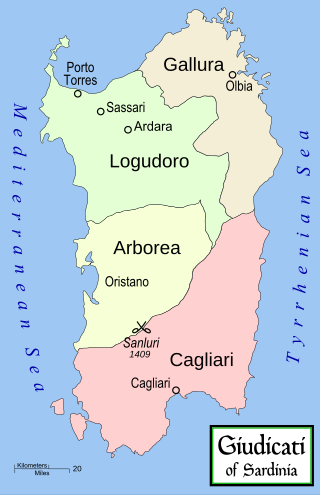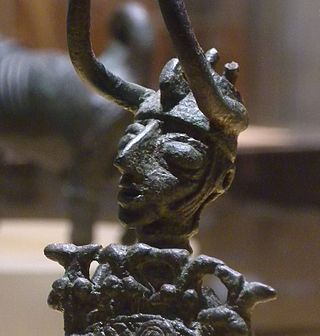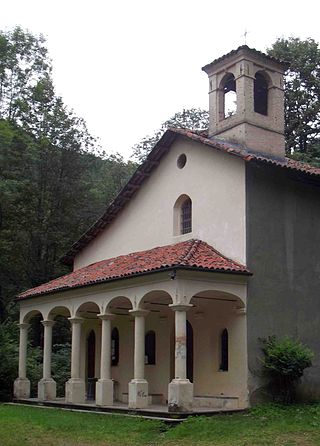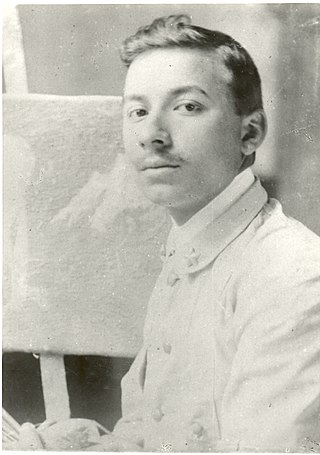
Sassarese is an Italo-Dalmatian language and transitional variety between Sardinian and Corsican. It is regarded as a Corso–Sardinian language because of Sassari's historic ties with Tuscany and geographical proximity to Corsica. Despite the robust Sardinian influences, it still keeps its Corsican roots, which closely relate it to Gallurese; the latter is linguistically considered a Corsican dialect despite its geographical location, although this claim is a matter of controversy. It has several similarities to the Italian language, and in particular to the old Italian dialects from Tuscany.

The Judicates, in English also referred to as Sardinian Kingdoms, Sardinian Judgedoms or Judicatures, were independent states that took power in Sardinia in the Middle Ages, between the ninth and fifteenth centuries. They were sovereign states with summa potestas, each with a ruler called judge, with the powers of a king.

Refrontolo is a comune (municipality) in the Province of Treviso in the Italian region Veneto, located about 50 kilometres north of Venice and about 30 km (19 mi) north of Treviso, representing the third smallest municipality by number of inhabitants (1,732) in the province, preceded only by Portobuffolé and Monfumo. It is located in a hilly viewpoint between Quartier del Piave and Montello, and it is crossed by the Prosecco and Conegliano-Valdobbiadene Hills Wine Road established in 1966. The municipality is in fact famous for the production of the Marzemino wine. Since July 7, 2019, Refrontolo's hills have been inscribed as an UNESCO World Heritage Site as The Prosecco Hills of Conegliano and Valdobbiadene.

Alma Franca Maria Norsa, known professionally as Franca Valeri, was an Italian actress, playwright, screenwriter, author, and theatre director.

The Five Days of Milan was an insurrection and a major event in the Revolutionary Year of 1848 that started the First Italian War of Independence. On 18 March, a rebellion arose in the city of Milan which in five days of street fighting drove Marshal Radetzky and his Austrian soldiers from the city.

Alessandro Barbero is an Italian historian, novelist and essayist.

Monte Arcosu is a mountain in the Sulcis massif, in southern Sardinia, Italy. It has an elevation of 948 metres (3,110 ft).

The Nuragic civilization, also known as the Nuragic culture, was a civilization or culture on the Mediterranean island of Sardinia, Italy, which lasted from the 18th century BC up to the Roman colonization in 238 BC. Others date the culture as lasting at least until the 2nd century AD and in some areas, namely the Barbagia, to the 6th century AD or possibly even to the 11th century AD.

The Giara di Gesturi, Sardinian: Sa Jara Manna, is a high, steep-sided basaltic plateau which extends for about 42 km2 (16 sq mi) in the districts (comuni) of Gesturi, Tuili and Setzu in the province of Medio Campidano, and Genoni in the province of Oristano, in the southern central part of the island of Sardinia, Italy.

Juti Ravenna was an Italian painter.

The Nuragic bronze statuettes are typical Nuragic Sardinian bronze sculptures of the final phase of the Bronze Age and the early Iron Age.

The Moglietti sanctuary is a sanctuary devoted to Our Lady of Graces in the comune of Coggiola.
The following is a timeline of the history of the city of Ferrara in the Emilia-Romagna region of Italy.
San Donato is a village in Tuscany, central Italy, administratively a frazione of the comune of Orbetello, province of Grosseto, in the Tuscan Maremma. At the time of the 2011 census its population amounted to 18.

The Sardinian Romanesque is the Romanesque architectural style that developed in Sardinia. The Romanesque architecture in Sardinia has had a remarkable development since the early origins, during the Giudicati era, and for a long period. His expressions, although autonomous, are not classifiable in a recognizable image, since in the island the Romanesque manifested itself with unusual results but in numerous forms; this is due to the establishment in Sardinia of several religious orders, coming from various Italian regions and from France. Consequently, in the architectures of that era Pisan, Lombard and Provençal influences are recognizable as well as traces of the passage of workers, coming from the Iberian Peninsula, of Islamic culture.

Pietà is an oil on panel painting by Sebastiano del Piombo, executed c. 1516–1517, now in the Museo civico in Viterbo.

Giuseppe Graziosi was an Italian sculptor, painter and graphic designer.
Pietro Perreau was an Italian librarian and Hebraist.

Sardinian surnames are surnames with origins from the Sardinian language or a long, identifiable tradition on the Western Mediterranean island of Sardinia.


















